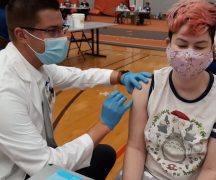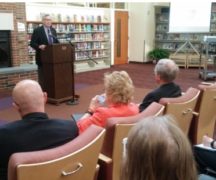By JULIE CARLE
BG Independent News
Artificial intelligence is everywhere and a part of everyday life.
It’s Apple’s Siri, Amazon’s Alexa, that Roomba that’s vacuuming your floors. AI makes it possible for machines to learn from experience and perform human-like tasks.
The past year has seen a boom in AI advances, particularly in text and images generated by computers from prompts. On the academic front, when OpenAI’s ChatGPT was introduced in November 2022, its impact on students’ writing assignments became a real concern for educators.
Several Bowling Green State University faculty members within the University Writing Program are among those academics who decided to take a proactive approach.
Dr. Neil Baird, director of the University Writing Program heard about it at the end of fall semester and spent time over winter break learning more about it. When the new year started, his effort to understand the tool was joined by Holly Bird, UWP associate director, and Charity Givens, UWP assistant director. Together they decided to “dive in, use it and learn its capabilities,” Baird said.
They talked to some instructors who were dealing with some writings by international students who were more familiar with the tool. They learned it was difficult to prove if a student used such a tool in their writing. “That’s why when our team found out about it, we wanted to get ahead of it and start to think of protocols to put into place to avoid the awful word – plagiarism,” Bird said.
“As writing teachers, the thing we probably dislike the most is having to deal with issues of academic honesty and plagiarism. A lot of faculty see things moving in that direction,” Baird said.
However, the writing that is produced is not technically plagiarism because no original work is being copied, which makes AI-assisted writing difficult to detect.
There are some apps that claim to detect AI-written content, but at the time of the interview, none of the team had first-hand knowledge of their effectiveness.
“Faculty do have a number of concerns. Anytime you have AI-assisted or the idea of artificial intelligence, we think about the Terminator or Skynet taking over. Some people worry about that,” Baird said.
Faculty are frustrated because those concerns are not going to go away. They impact the way writing will be taught moving forward.
“We are taking a more productive view of the situation. Our goal is to share our experiences with the app and help people, especially those people who have never seen what it can do when you input commands and ask it to produce things,” Baird said.
Among the biggest takeaways for the writing program faculty is the idea of effectively engaging use of the app in the writing classrooms. The goal is to introduce students to the app ethically.
Just as they teach students how to use Grammarly to write proper citations, “we have to teach ethical use of ChatGPT and other AI-assisted tools and how to use them effectively,” Baird said.
Givens noticed on faculty listservs that professors were concerned with catching students who were using the tool. “If they are only concerned with the end product, it creates an antagonistic relationship between professors and their students,” she said. “Plagiarism is criminalized, and I don’t know if it should be. You have not committed a crime if you plagiarize; you have made a bad choice and according to our standards of writing it’s not a good thing.”
“Our goal is to calm people down. ChatGPT is not the end of the world, but it is a tool like no other. We want to engage it and help students engage it in ethical ways,” Baird said.
Givens suggested AI-assisted tools “can be folded into the classroom conversation, instead of looking at it as a tool that is definitely going to make people cheat.”
They are working to create an AI-assisted writing tool resource guide that instructors might be able to use to productively introduce their students to the technology and teach its ethical use. Additionally, they are developing documents that can help faculty develop strategies for productively engaging it in the classroom, how to develop and design writing experiences “that are tailored to, and intimately connected with, the learning outcomes of their courses,” Baird said.
“It’s all about connecting to what faculty want to have happen in their course. They are passionate and motivated about their learning outcomes, so if we can connect how they can better achieve those learning outcomes they will be more invested in the process,” he said.
“Using ChatGPT as invention is something we talked about,” Bird said. For example, the tool could possibly be used to revise survey questions that would better meet the research goals, better target the audience and be ethical questions.
“This isn’t going away. Instead of labeling it as evil or bad, how can we integrate it in a meaningful, productive and ethical way in the classroom?” Baird said.





